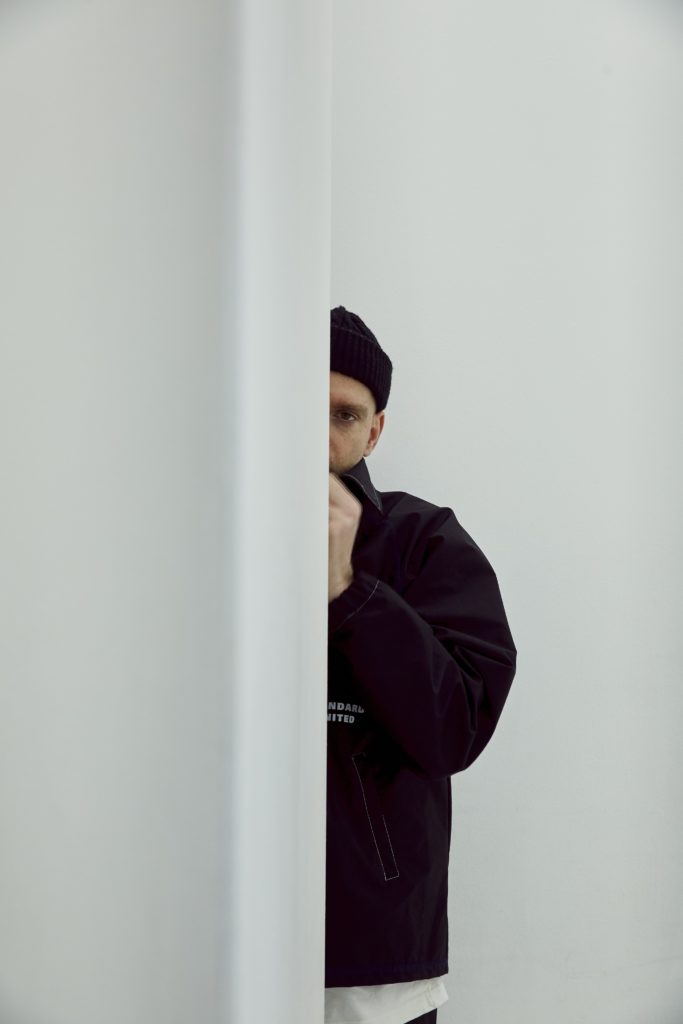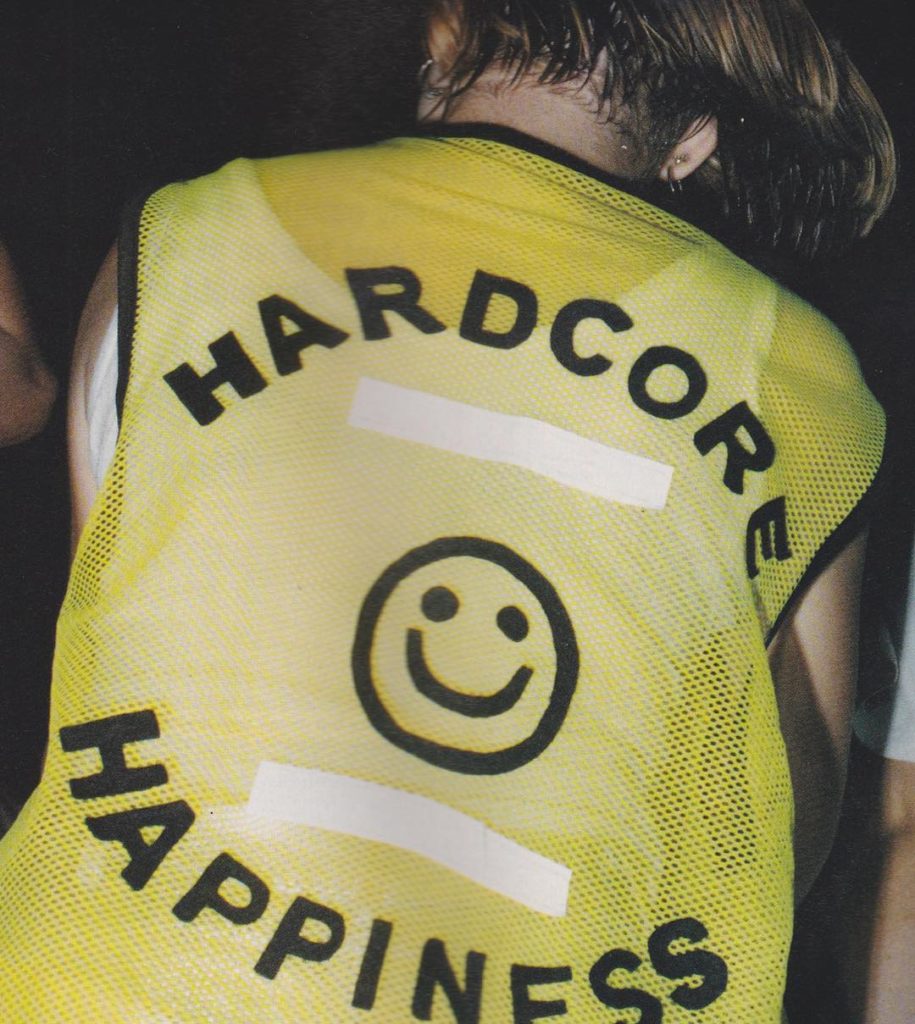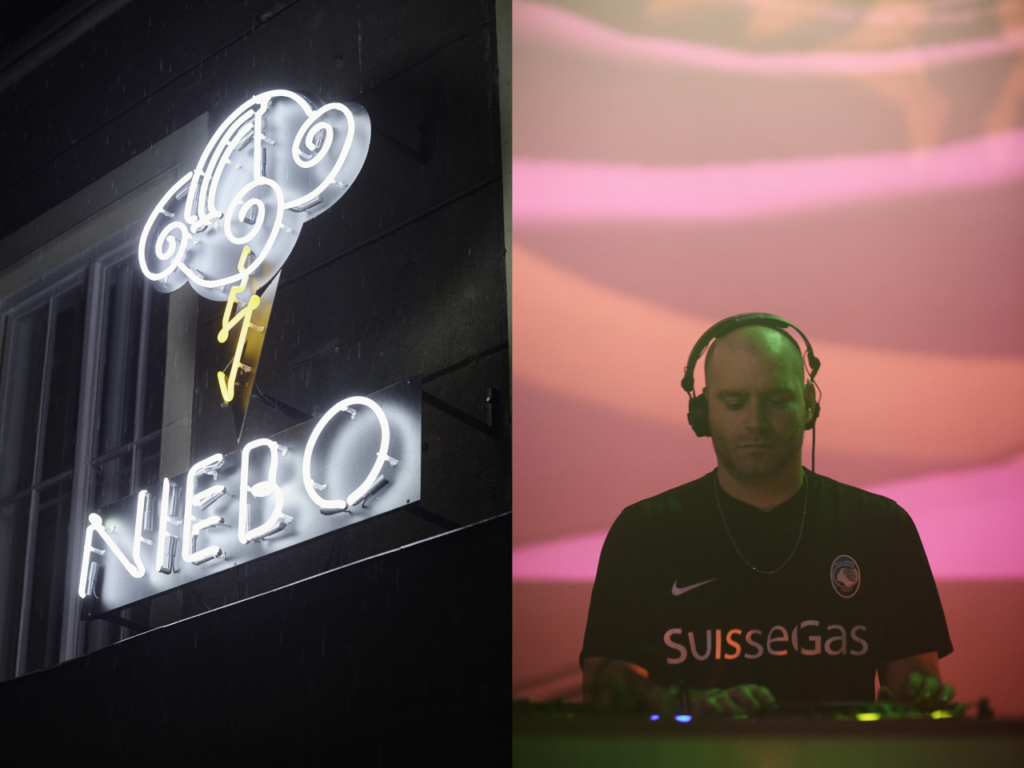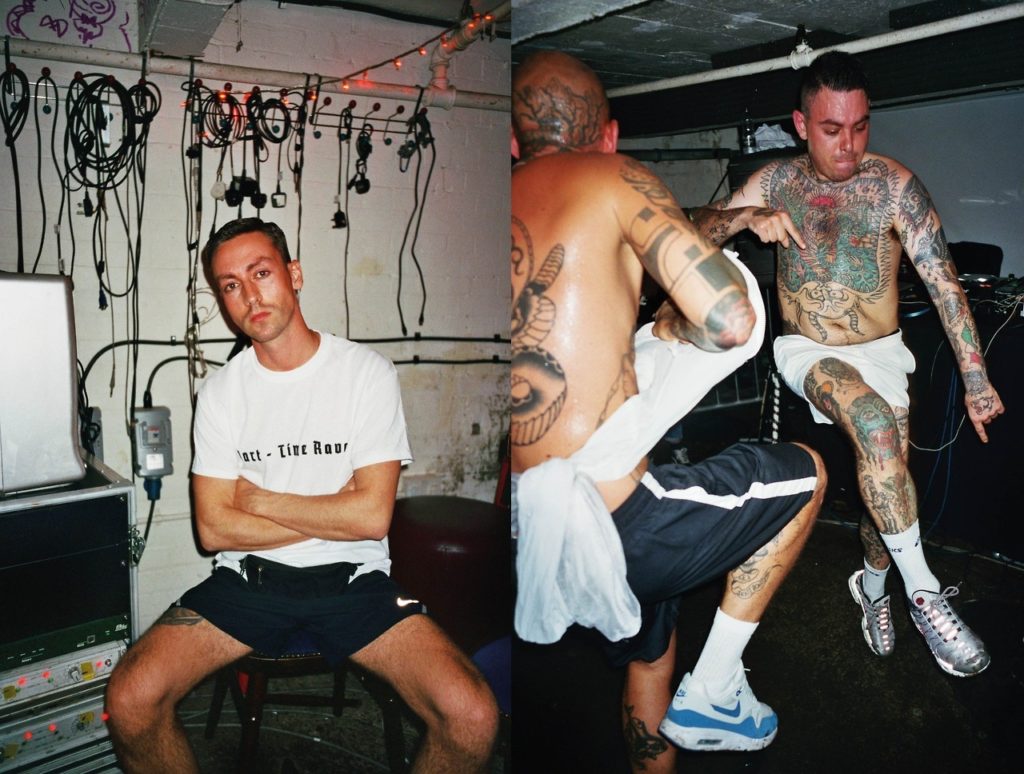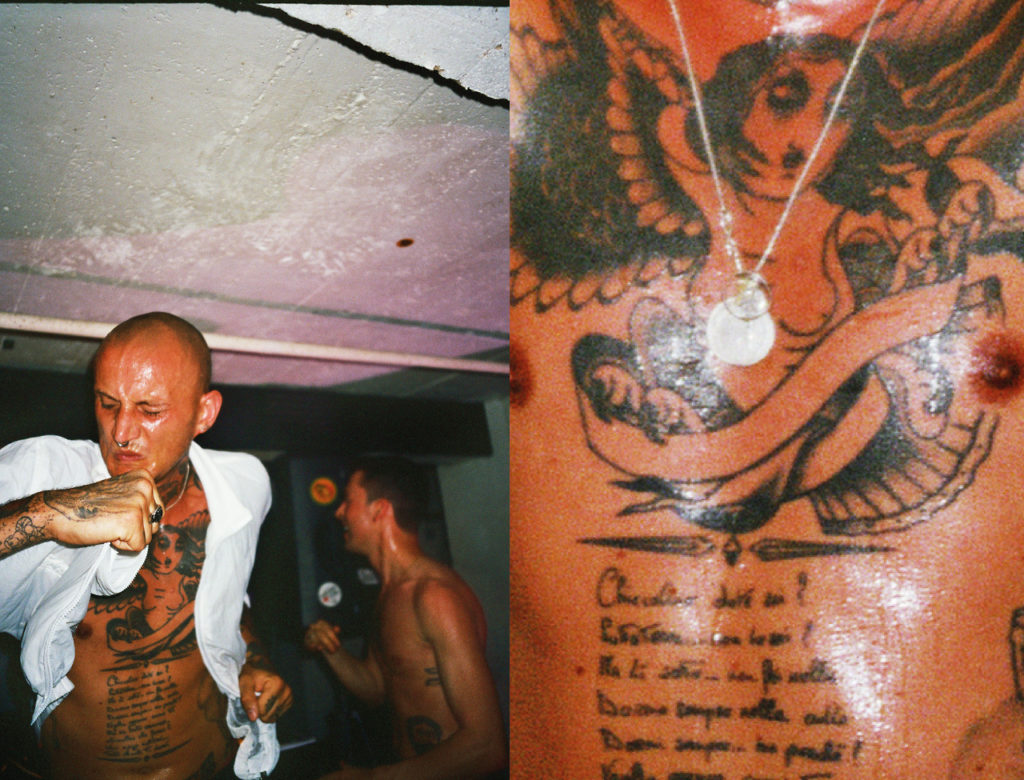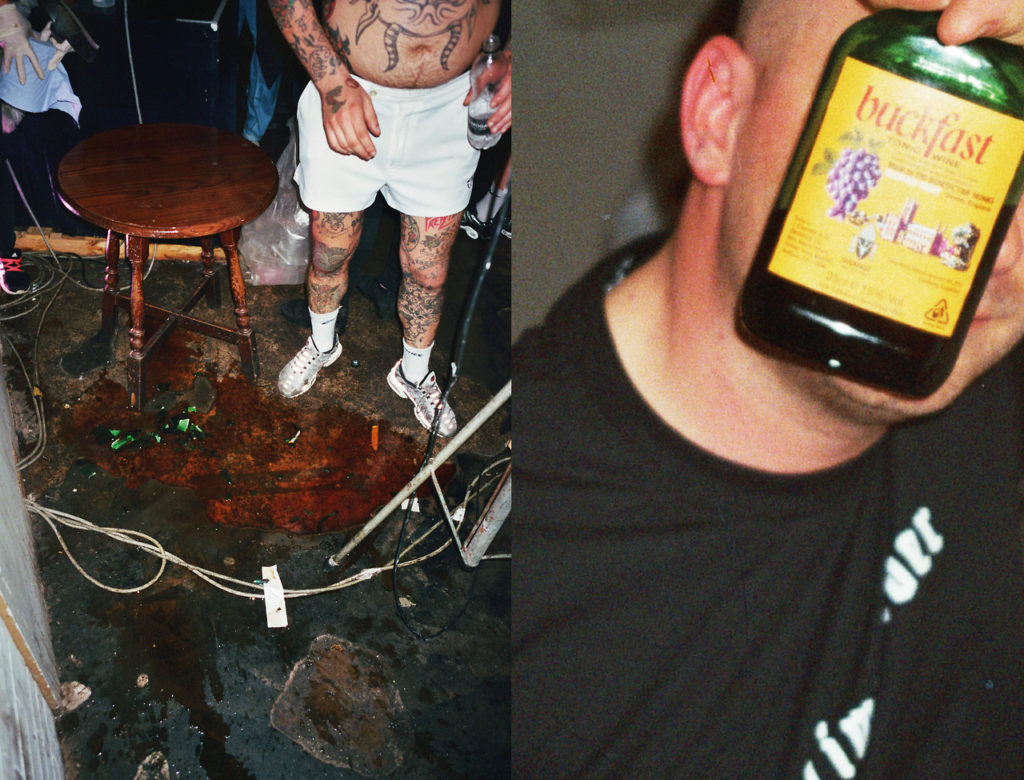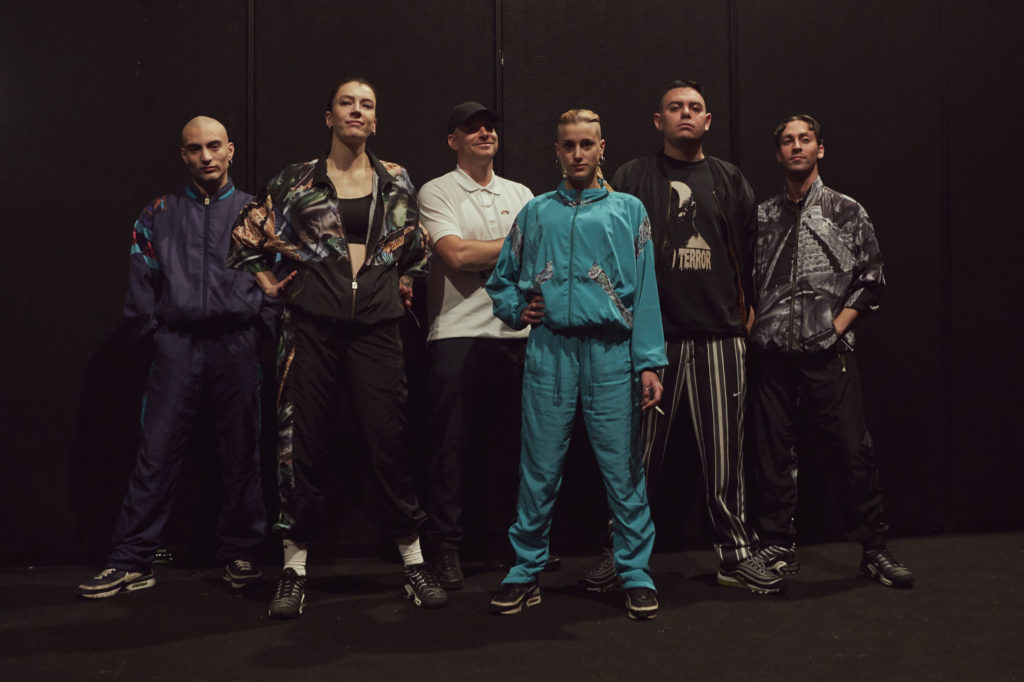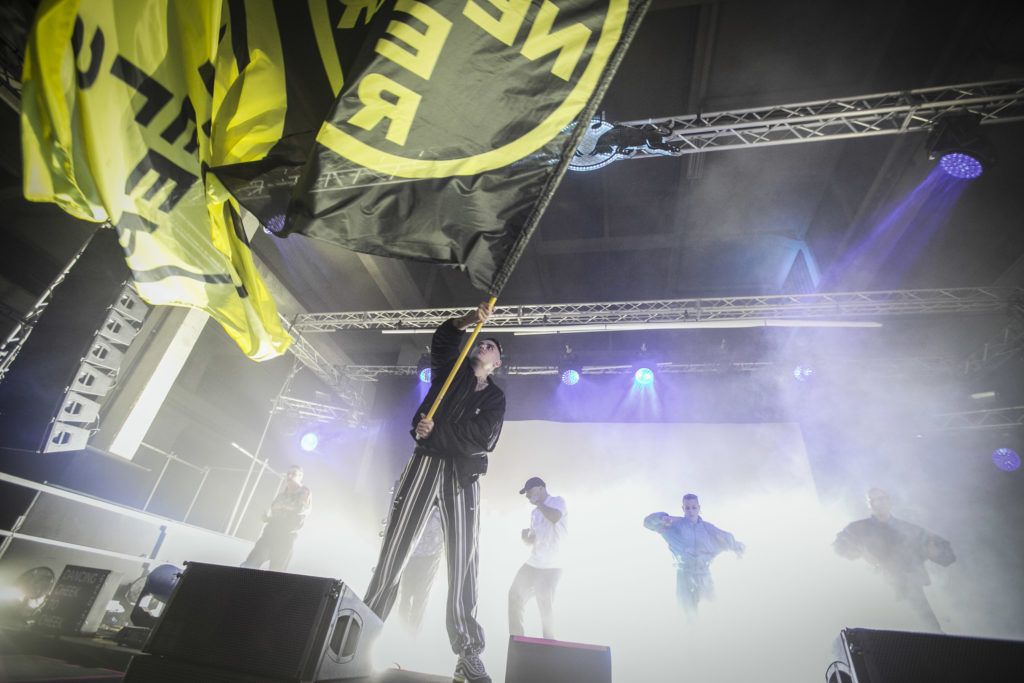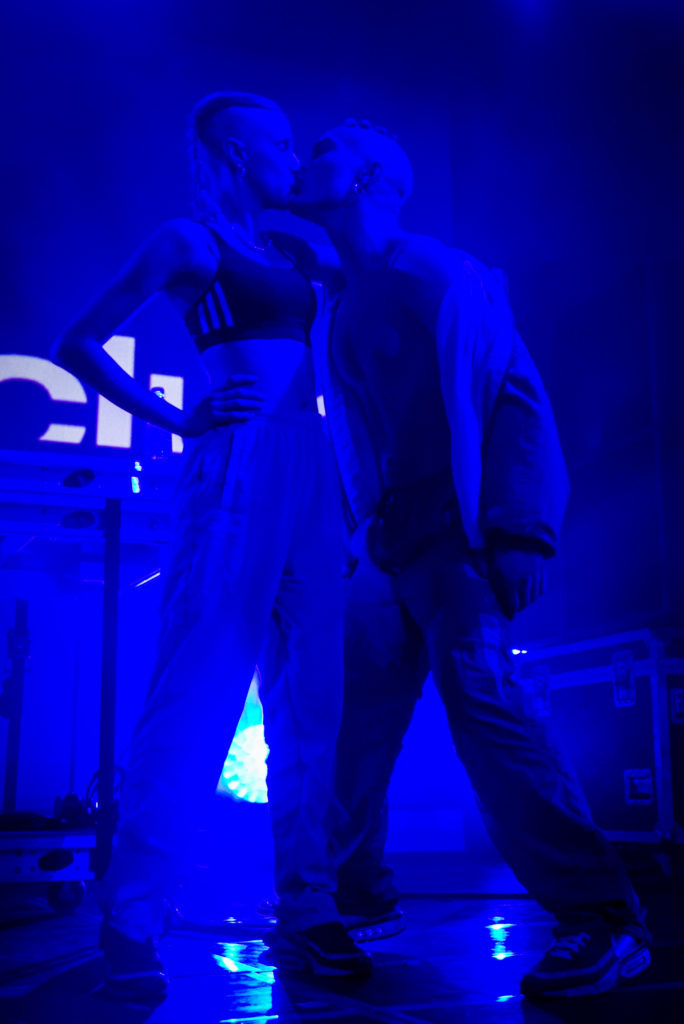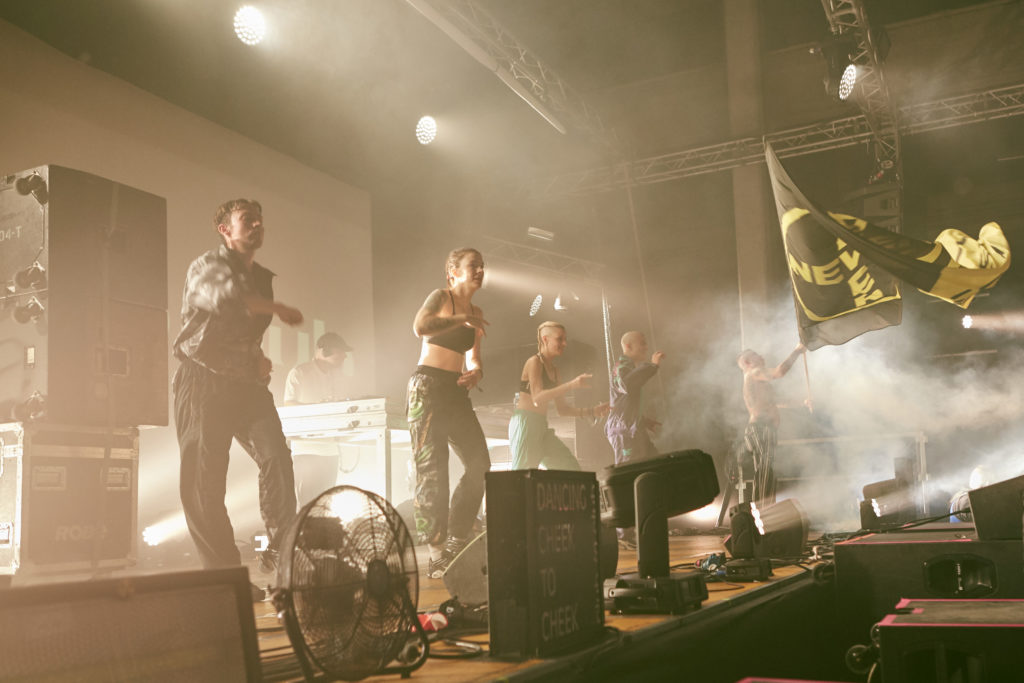Alberto Guerrini is a gabber. For him, hardcore is a way of life. Like millions of others born in the 80s, music was a primary form of escapism—or a catalyst for “suburban euphoria,” as he puts it on his website. Guerrini, or “El Diablo” to his friends, began flirting with hardcore culture in his highschool years. Later, in 2011, he co-published a zine called Gabber In The Name Of Love,[1] which sparked the eponymous blog; Gabber Eleganza is an archival gateway into the scene’s underworld.
Over the past couple years, Guerrini has been quietly building a profile as a hardcore revivalist by selling bootleg clothing, touring as a DJ with the “Hakke” dancing show, putting out an experimental record, and even doing art curation for Dior Homme. With fresh eyes and ears demonstrating an appetite for extreme sportswear and sounds north of 180 BPM, there’s renewed interest in a long-troubled culture—both on- and offline.
Conor McTernan caught up with Guerrini before a DJ set in London last December to talk about his role in keeping the spirit alive.
Conor McTernan Do you recall the first time you heard hardcore music?
Alberto Guerrini It was at my hometown street market, which takes place every Wednesday. In the summer it was a meeting point for kids to buy illegal bootleg tapes. Circa 1996 to 1997 was the peak of the hardcore boom in Italy. Around the same time my cousin and some older friends were circulating hardcore tapes. We would listen to broadcasts on Radio Base 87.5. “Hey you are on Radio Base 87.5. This is from the number one discotheque, this is the Hardcore Warriors… bam bam bam bam!” It was quite strange as I was ten years old, so my daily routine aside from this was watching cartoons and listening to pop music… I wasn’t just into hardcore as a kid. We were into Gigi D’Agostino, italo classics, hard dance stuff from Mauro Picotto, and also a lot of hip hop, which is still the music I listen to most in my car.
CMT What is it about gabber culture that appeals to you so much?
AG I discovered the music (hardcore) before I discovered the sub-culture. The first time I encountered gabber was when I was 14, in my school’s study hall. There was a guy who was a couple of years older than me and also into hardcore. He told me about going to clubs and seeing the legends. He pointed out another guy in front of me and said, “he likes the music too.” I said: “But he looks a bit different than me?” He responded: “Yeah… he’s a gabberhead.” I looked at the guy, who was bald and wearing a tracksuit. I thought: “shit… this is cool!”
I’ve always loved clothes and sportswear, but I was never into shocking people. For me gabber is a really minimal and pragmatic style. As is the music; it’s just a beat—it’s really simple but also really iconic. It’s not aggressive, like skinhead culture, but at the same times it’s masculine and androgenic—the girls often dress like men. In the 90s, it was super simple. A white tracksuit with some texture, a bald head, maybe some rings. That’s it… Simple.
CMT Gabber fans have a striking physical appearance. You’ve faced problems in the past because of this. How do you react when people attack you for looking the way you do?
AG Obviously in the past some gabber fans have aligned to the right, but they are the minority. I’m a left leaning guy, so when someone compares my project to fascism it breaks my heart. But I know that there are people with prejudices who don’t understand that my project is more than some bald guy dancing on stage—just like punk. When it arrived in Italy it was popular with the art kids, but people assumed they were fascists. I’ve met fascist gabber kids in the past. They are the ones who do stupid poses with pills in their mouths. These guys are less than 5% of the scene. In reality, Nazis hate gabber fans… they see the scene mainly as people who go to raves and listen to techno and black music. Lots of black people dance to hardcore too.
CMT Let’s talk about your merchandise. It’s quite popular. Did you expect this?
AG [Laughts] No. I started with four t-shirts, which sold out in one day. I never expected things to sell so fast. I just posted a picture on Instagram and bought my Big Cartel upgrade for GBP 10 a month. I’ve started working with a couple of stores in Tokyo, Taipei, and now Milan. The money is a nice base to start a new project like a label, which I am in the process of doing.
My friend Marco at Studio Temp helps me out with vectors for design, and there is a print studio that helps me with silk-screening. I’ve always been into creative processes—graphic design, creative direction, and the music especially. It’s a 360-degree project.
CMT In the last run, there is a “Total Football” t-shirt. Are you a football fan or is this more about the trend of sportswear in the rave scene?
AG I’m a football fan. I respect the culture and I’m really interested in the folklore of youth subcultures like the Italian Ultras. Coming from Bergamo it really fascinates me. I like the phenomena around it. “Ultra” is another name for hooligan. But it’s also about: “As a fan, I’m more ULTRA than YOU!” It’s about extremism.
“Total Football” is the name of one of my tunes from the recent Never Sleep #1 EP. It’s about the democracy of a football team, everybody has the same role, and everyone can be exchanged. You can divide this song into five parts, switch it around, and it won’t change. It’s kind of the same idea. It’s a bit more abstract, and because it’s out on an experimental label—Presto!?—I wanted to experiment.
The graphics on the back of the shirt feature all the premier sports brands from teams across the various regions of Italy, like Kappa, Joma, Givova, Errea, Asics, Gola, Umbro, Nike… So the term “Sportswear Patriotism” is a bit of ironic fun.
CMT Your “Never Sleep” logo is a play on Bayer Pharmaceuticals, much like the “Gabba” reinterpretation of the Kappa logo—these playful renditions have struck a chord with people. Where did you come up with these bootlegs?
AG The “Gabba” logo is a bootleg of a bootleg. I believe it already existed elsewhere, I just put my own touch on it. I’ve always been a fan of the 90s and the European rave boom. I’m really into digging through old rave magazines, and in there you will find lots of bootlegged stuff. The NASA rave flyer in the USA was particularly famous. I come from that kind of heritage. The name “Gabber Eleganza” [translates to Gabber Elegance] is a bit nonsensical, it’s a paradox. My merchandise is also a bit ironic, because gabber isn’t supposed to be serious, rather a bit funny. The project, however, is serious.
CMT Are there any brand copyright issues?
AG No, I change everything. If you look at the hair in the “Gabba” logo it’s different and on the Bayer logo the circle is bigger and the text is bolder. It’s clearly a rip off, but I’ve changed it enough. If they wrote to me I would ask them if they would like to collaborate, otherwise I would stop and move on to something new.
CMT When or where do you think the cultures of gabber and high fashion collided?
AG I’ve never been into high fashion, but I like style and I’m curious about trends. Sportswear has blown up in the last two to three years, for instance the aesthetic of Gosha Rubchinskiy’s tracksuits. Next year we’ll probably see “Gabba” t-shirts in Topshop.
If you look back, the early Raf Simons collections were always about music. There was the techno couture collection (2011), another one inspired by new wave, the Kraftwerk aesthetic (1998), and the 1999 to 2000 catwalk collection featured a hardcore soundtrack.[2]
CMT You mentioned that Gabber Eleganza is slightly ironic. Have you had any reactions from other hardcore purists to the “gabber fashion” trend that you’re a part of?
AG If you look at my blog archive, you will see that I always credit the photographers or artists. 95% of gabberheads in Italy gave me good feedback before I started the “Hakke” show. There are some who criticize my choice to take my work past the blog, as a DJ, because they want to protect the hardcore scene. Many articles were written in Italy after my Club To Club show last year. There are some hardcore heads that think that my project is a commercial push to make gabber become mainstream.
CMT What is your response to people who feel that way?
AG Many people have a prejudice against gabber, and that’s just part of the game. Through my blog I hope to re-evaluate gabber and extreme post-rave scenes and to bring them into the general public’s eye. I get many kids writing to me saying that they’ve discovered gabber through me. Others write to me saying, “thank you for pushing gabber,” with a respectful touch.
CMT You collect gabber memorabilia and have also create a zine of your own: Gabber In The Name Of Love [Automatic Books, 2009].
AG Yes, I created it with Marco Fusoloni at Studio Temp, who is one of my best friends. We decided to make a fanzine together about gabber. We started taking pictures at raves and creating our own artwork collages. We printed 100 editions with Automatic Books, a publisher from Venice, and did an event during the Venice Biennale. They sold out really fast and it was nice! That was my first project with gabber, and it’s what gave me the energy to start the blog.
CMT Was there a holy grail of gabber fanzines in the 90s?
AG Thunder. It was produced by ID&T, the Dutch promoters behind Thunderdome. They produced thirty-five issues over a couple of years, and I bought all of them for about two euro each. There was another one called Strobe, which was a glossy magazine. It was a mix of techno and hardcore.
CMT Where do you generally look to find these things today?
AG Usually on the internet. I’m a nerd.
CMT How about the ultimate hardcore rave destination?
AG Again, Thunderdome was the biggest by far. ID&T were huge marketing heads, so they created the most important hardcore brand in the world. I never visited in the 90s, but they did one last year which attracted 40 000 people. I went to the one before that, in 2012. It was all about nostalgia. Digital and Razorblade were some other big ones.
In Holland, the gabber revival is about pop culture. It’s one of the biggest sub-cultures they have. Holland is like the Jamaica of Europe—all their music is top quality. They are the kings of trance, the EDM artists are the best at EDM. Maybe not as much techno, but the weirder stuff there like Clone, Rush Hour, Dekmantel are all fucking huge… Dutch power.
AG Yes, we are friends. I met Paul Ozoni, one of the guys, in 2013. He wrote to me on Tumblr to say he liked my blog, and he wanted to put on an event together in Paris. Two weeks later he took a bus from Paris and came to stay at my house. I’ve since visited and played a couple of times with them in Paris.
CMT “Suburban Euphoria” is a keyword on your website. Can you explain that idea or how it relates to the context of your home in Bergamo, Lombardy?
AG I come from a tiny town named Calco. It’s a flat place with highways and cows—a mix of working class areas, countryside farms, and deep depression. It’s a boring place to live but at the same time it’s a comfort zone because nothing happens… It’s the perfect place to die on drugs.
Bergamo is a big countryside city, and a wealthy place. “Suburban Euphoria” is about escapism. When I started the blog with the “digital folk” aesthetic it became about more than just gabber. It’s a similar feeling to the suburbs of England or Scotland. People listen to different music, but it’s the same attitude or style, it’s a kind of romanticism.
CMT When was the moment you realized that this project was something you could do for a living?
AG When I started receiving ten e-mails every day about some form of collaboration, a gig, or someone’s merchandise order that had not arrived on time. After last summer, I decided this was my work, and I wanted to evolve it because I love it and enjoy it.
CMT What work or career did you have previously?
AG My father is a baker, so I worked in his bakery for several years. Listening to hardcore on my headphones, selling bread to old ladies. [Laughs] I was also a dog-sitter for two years. Meanwhile I started promoting nights and DJing in Bergamo. I opened an independent store and an event agency with my wife. We sold clothes and vinyl, and ran music and cultural events such as artisanal fairs in Bergamo. It was open for seven years and closed three years ago.
CMT been touring your “Hakke” show this year. Where did you recruit all the dancers in your crew?
AG They are all ex-gabberheads. The first three shows were with close friends, and I asked a young gabber couple—aged 18 and 19—to join-in to bring some new energy. My friend Mino is the one who waves the giant flag. He’s a traditional tattoo artist by trade. Originally an outsider to gabber, he’s become a hardcore head through the project. He’s a great motivator and the bridge between the dancers and the crowd.
CMT What does it mean to you being a gabberhead?
AG The meaning of gabber is “friend,” like your partner in crime. The raver has changed, but I think the electronic music scene needs something like gabber, not for the sound, but for the energy of the music. It’s like dirty punk, it keeps the energy alive through the spirit of rave… And rave is revolution.
[1] see http://www.madeintemp.com/2013/gabber-in-the-name-of-love/
[2] Simons’ Spring/Summer 2000 “Summa Cum Laude” collection, features a famous oversized MA-1 bomber jacket, with the pyramid logo of the Rotterdam Terror Corps on the back.
Hardcore Soul is out now. Grab your copy over here. And do not miss out on this mixtape that comes along with the book:
